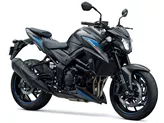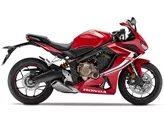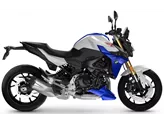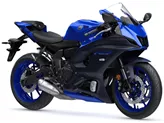Kawasaki Z900 2017 vs. Kawasaki Ninja 650 2017

Kawasaki Z900 2017

Kawasaki Ninja 650 2017
Overview - Kawasaki Z900 2017 vs Kawasaki Ninja 650 2017
The Kawasaki Z900 2017 and the Kawasaki Ninja 650 2017 are both excellent motorcycles, but they have some key differences in terms of their technical specifications and strengths.
Starting with the Kawasaki Z900 2017, it is a naked bike with a powerful engine. It has an in-line engine type with a displacement of 948ccm. The engine produces 125.4 HP of power and 98.6 Nm of torque, making it a high-performance motorcycle. The Z900 has a compression ratio of 11.8 and a fuel system with injection. It also features a liquid cooling system to keep the engine temperature in check. The Z900 has a steel double cradle frame and a front suspension with an upside-down telescopic fork. The front suspension has a diameter of 41 mm, providing stability and control. The rear suspension is a swing arm with a monoshock and offers preload and rebound adjustment. The Z900 has double disk brakes on the front with a diameter of 300 mm and four pistons. It also comes with ABS as an advanced rider assistance system. The Z900 has a wheelbase of 1450 mm and a seat height of 795 mm. It weighs 210 kg with ABS.

Kawasaki Z900 2017
The strengths of the Kawasaki Z900 2017 lie in its ingenious naked bike chassis, superb looks, and powerful engine. The engine is responsive and revs up willingly, providing a perfectly dimensioned torque. It offers an optimum intersection of performance, price, and practical use.
On the other hand, the Kawasaki Ninja 650 2017 is a supersport motorcycle with a slightly less powerful engine compared to the Z900. It has an in-line engine type with a displacement of 649ccm. The engine produces 68.2 HP of power and 65.7 Nm of torque. The compression ratio is 10.8, and it also has a fuel system with injection. The Ninja 650 has a steel tubular frame and a front suspension with a telescopic fork. The front suspension has a diameter of 41 mm, providing stability and control. The rear suspension is a swing arm with a monoshock and offers preload adjustment. Similar to the Z900, the Ninja 650 has double disk brakes on the front with a diameter of 300 mm. It also comes with ABS as an advanced rider assistance system. The Ninja 650 has a wheelbase of 1410 mm and a seat height of 790 mm. It weighs 193 kg with ABS.
The strengths of the Kawasaki Ninja 650 2017 lie in its transparent chassis for sport, playful and good-natured handling, excellent brakes, and sharp looks similar to the ZX-10R. The engine is also resilient, providing a smooth and enjoyable riding experience.

Kawasaki Ninja 650 2017
In terms of weaknesses, the Kawasaki Z900 2017 has a narrow knee angle for tall people, which may require ordering a different seat for added comfort. On the other hand, the Kawasaki Ninja 650 2017 has a lack of sound from the stock exhaust and may exhibit slight vibrations from the engine.
In conclusion, the Kawasaki Z900 2017 and the Kawasaki Ninja 650 2017 are both impressive motorcycles with their own unique strengths and weaknesses. The Z900 offers a more powerful engine and a naked bike design, while the Ninja 650 offers a sportier chassis and a slightly less powerful engine. Ultimately, the choice between the two will depend on the rider's preferences and intended use for the motorcycle.
Technical Specifications Kawasaki Z900 2017 compared to Kawasaki Ninja 650 2017
Pros and Cons in comparison
Pros and Cons in comparison
Kawasaki Z900 2017

An incredibly well-designed motorbike. A lot of test work and attention to detail went into it. It has exactly the right power, exactly the right chassis and exactly the right look. An all-round successful naked bike that will make you happy for a long time. If you like, you can ride it simply and faithfully, but if you want, you can also ride it really fast and it wheels like hell. Great!
Kawasaki Ninja 650 2017

The Ninja 650 firmly stamps its predecessor (Er-6f). The engine has mastered the Euro 4 hurdle well and serves up a very usable 68 hp, the chassis is simply great for this class, and the weight reduction of 18(!) kilos compared to the ER-6f justifies reverent nods.
Price Comparison Avarage Market Price Kawasaki Z900 vs Kawasaki Ninja 650
There are a few key differences between a Kawasaki Z900 2017 and a Kawasaki Ninja 650 2017. In terms of price, the actual average price of a Kawasaki Z900 2017 is about 36% higher. A Kawasaki Z900 2017 experiences a loss of 520 USD in one year and 920 USD in two years of ownership. This is offset by a loss of 380 USD and 500 USD for a Kawasaki Ninja 650 2017. Compared to Kawasaki Ninja 650 2017 there are more Kawasaki Z900 2017 bikes available on the 1000PS.de Marketplace, specifically 43 compared to 7. It takes less time to sell a Kawasaki Z900 with 85 days compared to 96 days for a Kawasaki Ninja 650. Since model year 2017 1000PS.de editors have written 46 reviews for the Kawasaki Z900 and 20 reviews for the Kawasaki Ninja 650 since model year 2017. The first review for the Kawasaki Z900 was published on 11/11/2016 and now has more than 93,200 views. This compares to more than 79,600 views for the first review on Kawasaki Ninja 650 published on 10/4/2016.





















